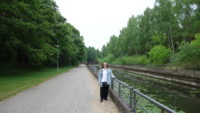 Dirt (and sand) was an important theme today. From roads to holes to beaches, dirt was an issue. We left the Šiauliai hotel this morning and drove west for about two hours, following my GPS. I wasn’t paying too close attention (I was in mid-yawn) when it told me to turn left. I hadn’t even seen a road there, and that was largely because it was small. It was a one-ish lane road taking us into the middle of a national park. Fair enough.
Dirt (and sand) was an important theme today. From roads to holes to beaches, dirt was an issue. We left the Šiauliai hotel this morning and drove west for about two hours, following my GPS. I wasn’t paying too close attention (I was in mid-yawn) when it told me to turn left. I hadn’t even seen a road there, and that was largely because it was small. It was a one-ish lane road taking us into the middle of a national park. Fair enough.
Then the pavement ended, and we got our one-ish lane dirt road. In a sign of how dedicated Lithuanians are to the outdoors, the wide and paved sidewalk continued. As we bounced along the dirt road, Mer began to question where the heck we were going, and thought maybe the GPS was wrong. Nope. We pulled up to a parking lot outside a mostly empty field that was gated with four layers of barbed and electric wire. I have the best outings for my wife.
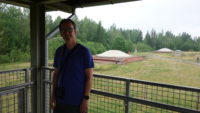 We were in the middle of nowhere because that is where the Soviet Union decided to build its first underground missile base. They chose this site in Lithuania because it was close enough for the mid-range missiles to hit all of western Europe, and because the soil was sandy, making it easy to dig. And, when you have a nigh endless supply of labor, you bring in ten thousand soldiers with shovels to dig out four missile silos by hand. I’m not sure if digging equipment would have been seen by spy flights or if the men were just cheaper, but they dug out four one-hundred-foot-deep silos and the support/command bunkers, all by hand.
We were in the middle of nowhere because that is where the Soviet Union decided to build its first underground missile base. They chose this site in Lithuania because it was close enough for the mid-range missiles to hit all of western Europe, and because the soil was sandy, making it easy to dig. And, when you have a nigh endless supply of labor, you bring in ten thousand soldiers with shovels to dig out four missile silos by hand. I’m not sure if digging equipment would have been seen by spy flights or if the men were just cheaper, but they dug out four one-hundred-foot-deep silos and the support/command bunkers, all by hand.
The grounds of the base had been protected by four or five layers of wire. Some of them were just barbed wire, but all of them could detect a breech and alert the commanders. One fence delivered a lethal amount of electricity to anyone who touched it. The fences were also patrolled, and there were phones hidden in trees for efficient communication.
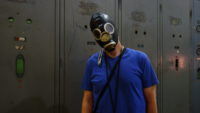 The bunker was entered though three pressure doors. In the case of an attack, the underground could be sealed off for up to three days, and it could withstand a nuclear blast from just a few miles away. The base missiles were pointed at Great Britain, West Germany, Norway, and Spain at various times. The silos became operational in the early sixties and were abandoned in the early eighties when the missiles there had become obsolete and it would have cost too much to update the silos. The men had to be able to report to duty within four minutes of an alarm sounding, and the rockets could be launched in forty-eight minutes. Happily, they never were. But it was close.
The bunker was entered though three pressure doors. In the case of an attack, the underground could be sealed off for up to three days, and it could withstand a nuclear blast from just a few miles away. The base missiles were pointed at Great Britain, West Germany, Norway, and Spain at various times. The silos became operational in the early sixties and were abandoned in the early eighties when the missiles there had become obsolete and it would have cost too much to update the silos. The men had to be able to report to duty within four minutes of an alarm sounding, and the rockets could be launched in forty-eight minutes. Happily, they never were. But it was close.
I knew about the Cuban Missile Crisis, of course. I had forgotten it was brought on by the US putting missiles in Turkey. Cuba was the first time the Soviets put missiles outside of their own border, and the US, to put it mildly, freaked. Kennedy embargoed the supply ships coming into Cuba, and the US went to DEFCON-2 (out of 5, where 1 is active nuclear war) for the only time in our history. Kennedy was within a few hours of authorizing an invasion of Cuba when diplomacy prevailed. The Soviets would withdraw their missiles if the US promised to not invade Cuba and if the US removed all nuclear weapons from Turkey. That worked for everybody.
(One odd note about the Cuban Missile Crisis display in the bunker – there were original newspapers from the time, and they were all The Bennington Banner. Bennington is a small town in Vermont. Not The New York Times or The Washington Post. The Bennington Banner. How does that even come to be?)
The second close call, the one I didn’t know about, was the “Prague Spring” uprising. In 1968, the new president of Czechoslovakia called for democratic reforms. The Soviets were afraid that the the Czechs would join Western Europe and that other Soviet-bloc countries would follow. So they sent in 500,000 troops and 5,000 tanks to put down any reforms. The leaders of the Soviet Union feared that NATO would invade Czechoslovakia, so they ordered warheads loaded on all missiles in Eastern Europe, which was the only time that happened.
In the end, the Americans and Soviets had enough power to wipe out the entire planet, so Reagan and Gorbachev signed a treaty to destroy all medium-range missiles. Both countries still had plenty of long-range missiles, but it was a start.
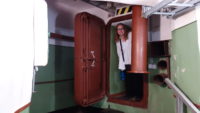 We learned all of this in the bunker for the silos. The various rooms housed information on the Cold War, on Soviet propaganda, on weapons and missile development, and more. We saw where fuel was stored (away from the men because it was so toxic), where the men worked (the radio operator was never allowed to take his headset off while on duty, so the wire was fifty feet long to let him go to the bathroom), and various other rooms. The large room that used to hold pressurized air had been converted to a film room showing peaceful scenes of nature and cities and museums. If you pushed the red button in the room, the room went red and the film was replaced by footage of test explosions of nuclear bombs. It was very effective.
We learned all of this in the bunker for the silos. The various rooms housed information on the Cold War, on Soviet propaganda, on weapons and missile development, and more. We saw where fuel was stored (away from the men because it was so toxic), where the men worked (the radio operator was never allowed to take his headset off while on duty, so the wire was fifty feet long to let him go to the bathroom), and various other rooms. The large room that used to hold pressurized air had been converted to a film room showing peaceful scenes of nature and cities and museums. If you pushed the red button in the room, the room went red and the film was replaced by footage of test explosions of nuclear bombs. It was very effective.
The tour showed off the majority of support rooms on the two levels of the bunker. It ended, not surprisingly, with one of the four silos itself. Even today it is an impressive sight.
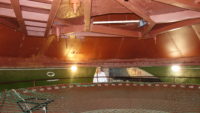 Our audioguide welcomed us to the museum and said we would be there about an hour. In the Riordan-house way of touring museums, we were there for three hours. It was a really well-done museum.
Our audioguide welcomed us to the museum and said we would be there about an hour. In the Riordan-house way of touring museums, we were there for three hours. It was a really well-done museum.
I had toyed around with going on to a World War II German bunker along the coast, but decided to get to our hotel in Palanga instead. Palanga is a small resort town on the Baltic Sea. As we drove up to our hotel neighborhood, it became odd. The houses and buildings were all new and top-notch – not cheap. But the road was mud. Our best guess is that the builders finish all the buildings first, and install the roads last. It creates an unusual juxtaposition. The hotel here really is very nice.
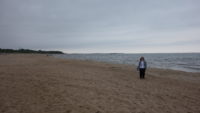 I decided to walk to the beach to see the sea. That took us by a large and pretty park of mature pines, and got us to the beach, about ten or fifteen minutes from our hotel. My plan of walking to town along the ocean was foiled by the tide being in, and it being very difficult to walk in the loose sand. It was a cool day and cloudy, and the water was only 55 degrees, so the beach was pretty deserted. We headed back to solid footing.
I decided to walk to the beach to see the sea. That took us by a large and pretty park of mature pines, and got us to the beach, about ten or fifteen minutes from our hotel. My plan of walking to town along the ocean was foiled by the tide being in, and it being very difficult to walk in the loose sand. It was a cool day and cloudy, and the water was only 55 degrees, so the beach was pretty deserted. We headed back to solid footing.
That wasn’t so bad. We started walking along the paved hike-and-bike trail that goes fifteen miles to the next town, and I saw a boardwalk. We took that, and it dumped us into the park forest, which led to a canal, which led to more boardwalks, and finally to the center of town. We did some mid-vacation errands (new toothbrush, fingernail clippers, cash from an ATM), and found an Italian place for supper. Even though they didn’t have English menus, they used enough Italian names for us to get a good meal. We followed that with dessert from a French bakery.
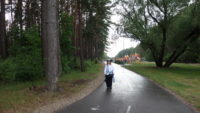 That was about it. We took a meandering, check-the-cell-phone-often way home that left me even more confused about navigating the town. It was almost like having sand in my eyes, but maybe it will be clearer tomorrow when Meredith takes over for two days here in town.
That was about it. We took a meandering, check-the-cell-phone-often way home that left me even more confused about navigating the town. It was almost like having sand in my eyes, but maybe it will be clearer tomorrow when Meredith takes over for two days here in town.
The bunker room with the red button sounds like it would have been pretty impressive.